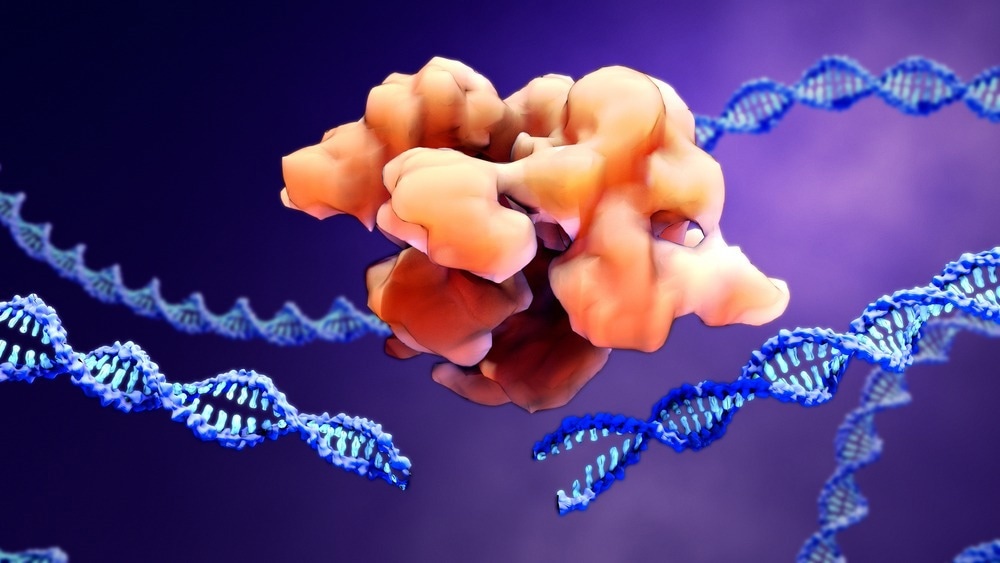Genome editing consists of a method that aids scientists in modifying or editing the DNA of many organisms, such as plants, bacteria, and animals. Subsequently, this can result in changes in the phenotype, including physical characteristics such as eye color, as well as being used to reduce disease risk.

Image Credit: Design_Cells/Shutterstock.com
Scientists or researchers can use different editing technology to modify or edit DNA, and this type of technology essentially holds the role of scissors that cut DNA at specific places. Once cut, DNA can be removed, added, or replaced to modify the genetic sequence affecting a person or patient.
The first genome editing technology was built in the late 1900s, while a novel genomic editing tool called CRISPR (clustered regularly interspaced short palindromic repeats) was developed in 2009. This revolutionary technology has been researched for many applications, including drug discovery, disease application, and even agriculture.
CRISPR
CRISPR has been described as a revolutionary tool, with this editing technology altering pieces of DNA and adapting to turn genes on and off without altering the sequence. This tool is more beneficial and promising than other editing tools that were time-consuming with high expenditure; the unveiling of CRISPR in 2012 has made genome editing cheap and easy.
This novel technology has transformed many fields, from medicine to agriculture, with some people already consuming food edited with CRISPR. The potential of CRISPR for medicine is also significant, with this editing tool enabling disease treatment as well as prevention through the altering of mutated DNA sequences that would lead to disease development.
The key to CRISPR includes a range of Cas proteins found in bacteria, with the role of defending against viruses. The Cas9 protein is used ubiquitously by scientists and can be programmed easily to detect and bind to target sequences through a piece of RNA used as a guide. The combination of the Cas9 protein and guide RNA moves along a DNA strand until it detects and binds to the desired sequence, which would be a 20-DNA-letter long sequence that is complementary to the guide RNA sequence.
Once the Cas9 protein cuts the DNA at the target sequence, the cut is repaired, and during this repair stage, mutations are introduced to disable the desired genes that lead to undesirable characteristics. This demonstrates the powerful tool that is CRISPR, as DNA in each cell includes six billion letters and is two meters in length.
Also, customized Cas proteins have been developed, which work differently and do not cut DNA or alter it. However, they turn genes on (CRISPRa) and off (CRISPRi). Other types also include base editors that modify nucleotide bases that make up DNA sequences and work by changing one nucleotide in the DNA code into another.
Drug Discovery Applications
Before gene editing, advancements in DNA sequencing technology, as well as omics technologies, including transcriptomics, proteomics, and metabolomics, have enabled disease comprehension at a genetic and cellular level to identify novel drug targets and biomarkers for drug discovery.
However, transformative gene editing, including CRISPR, has also impacted the field of drug discovery over the last decade. This is because CRISPR/Cas9 technology has been adopted in the drug discovery pipeline to generate critical disease models, such as cellular and animal models. These are used to investigate the role of novel drug targets that would significantly impact disease treatment. Once these drug targets have been identified, they can be used to develop effective drugs to treat a range of diseases and disorders.
Creating disease models using CRISPR can ensure similarities in the disease pathophysiology of humans, which can also be used to investigate the efficacy of potential drug agents.
Several novel therapeutics have been translated into a clinical setting, including antisense oligonucleotide, mRNA, protein, and gene and cell therapies. The significance of these therapies includes spearheading the drug discovery and therapeutics field as it postulates the potential of curing and treating every disease through identifying drug targets through genome editing technology.
Using genome editing in drug discovery along with current technology can further disease comprehension, enabling safer medicines and drugs to be developed. The drug treatments can also be targeted to patient populations to ensure the highest benefit and efficacy, which can lead to increased success rates for drug discovery and development.

Image Credit: Gorodenkoff/Shutterstock.com
Future Outlook
The revolutionary role of genome editing for drug discovery can be significant for drug development in the pharmaceutical industry. This can be seen by an increase in new molecular entities that have been approved by the Food and Drug Administration (FDA) in recent years, with over 40 novel medicines being approved per year between the years 2011-2020, compared to an average of approximately 20 novel medicines being approved per year between the years, 2001-2010.
The use of CRISPR/Cas9 can enhance the success of drug discovery by researchers as it can accelerate the identification of novel drug targets, increase comprehension of the role of these targets, and enhance model systems for new medicine. With the comprehensive nature of CRISPR/Cas9, the failure rate will be reduced. This can save time and cost for pharmaceutical companies and the industry compared to the traditional discovery and development approach, typically associated with a high failure rate and high expenditure.
Sources:
- Gaj, T. et al. (2016) “Genome-editing technologies: Principles and applications,” Cold Spring Harbor Perspectives in Biology, 8(12). Available at: https://doi.org/10.1101/cshperspect.a023754.
- Le Page, M. (no date) CRISPR, New Scientist. Available at: https://www.newscientist.com/definition/what-is-crispr/ (Accessed: January 11, 2023).
- Rees, S. (2022) “Genome editing in drug discovery,” Genome Editing in Drug Discovery, pp. 3–7. Available at: https://doi.org/10.1002/9781119671404.ch1.
- What is genome editing? (2019) Genome.gov. Available at: https://www.genome.gov/about-genomics/policy-issues/what-is-Genome-Editing (Accessed: January 11, 2023).
Further Reading